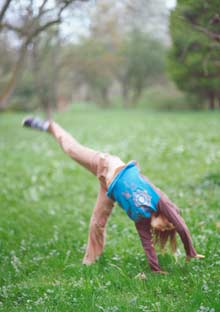Mastery Plan

Photo: © 2008 Jupiterimages Corporation
A photography business, a newspaper column, a published memoir: Kelly Corrigan thought life was about dabbling in many things—until her daughter showed her the satisfaction of perfecting just one.
"This is it!" I'd call to my husband, Edward. "Get the video camera!" Georgia was a year old. "Come on, baby! Take a step." She'd been torturing me for weeks, slowly lifting herself up and then freezing—studying the terrain, considering the consequences. I was the queen of diving in, of "Hey, why not?," and I guess I'd assumed that my daughter would be the same. "You can do it!" I'd cry. "One little baby step!" But it would be another six weeks before Georgia summoned the nerve to lift one foot off the ground and set it down in front of the other. Naturally it happened when I wasn't looking, perhaps even because I wasn't looking. Right around this time, I found an old Pentax in our storage space and started taking pictures. A few weeks later, I told Edward I was thinking of quitting my job designing educational software. "I want to be a photographer," I announced, handing him a set of black-and-whites. "Candid portraits." He responded with his signature squint, a look of derision, skepticism, and superiority all rolled into one. (Edward is a person who dares not begin anything that might not end with excellence, whereas I've been known to swing by the art supply store on the way home from the museum because "how hard can it be?")
I landed one photography client, then another. A nice man at the camera shop walked me through my contact sheets, showing me which frames to print. After my first big assignment, I ran back to the lab waving my check. "She couldn't believe this was my first job!" I reported. "I can't, either," said the nice man, beaming. That was all the confirmation I needed to say goodbye to educational software.
A year or two later, though, expectations had reset. Clients started asking if I did my own printing, if I would bring lights, if I could shoot in medium format. Nope, not me. If there are 10 steps to mastering photography, medium format is probably around Step 8. It's advanced. You are no longer taking big, easy strides, but rather inching ahead so slowly you wonder if you've moved forward at all. Too much work for too little gain, I thought.
By this time, Georgia was in preschool, distinguishing herself as the girl who drew flowers. Not hearts, or stick people, or big firecracker suns—just flowers. And really just one flower: a daisy-ish blossom that she honed and refined over the course of a year, like Monet and his water lilies. "Want me to show you how to draw a house?" I would ask. "I'm not finished with my flower," she'd answer. Really? It looked good enough to me. If I were Georgia, I'd have moved on months ago. I like the huge payoff of the steep learning curve. One day you're stumbling around and the next, you're doing it (skiing down the bunny slope, playing chopsticks on the piano, drawing a tree). I like impressing people ("Wow, you've never done this before?"). And I love always having a fresh answer to my favorite question, "What's new?"
Clearly, Georgia felt differently. And since I had some strong opinions on the matter—and was unwilling to devote myself to the finer points of photography—I put down my camera and picked up a pen. I had read enough poorly written newspaper columns to believe that I could beat the average. I whipped up a sample essay (about teaching kids to approach new things with optimism); one month later, my name and photo were on the front page of The Piedmonter, my California town's weekly paper. Just like that, I was a "columnist": $50 per column, two columns a month. People at cocktail parties seemed impressed. Edward stopped squinting. When I walked Georgia to school, she ran from driveway to driveway looking for my face on the morning's paper.



